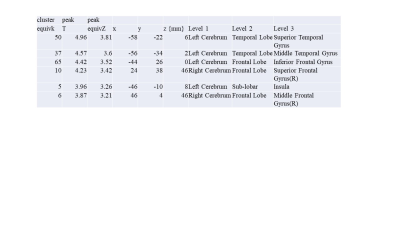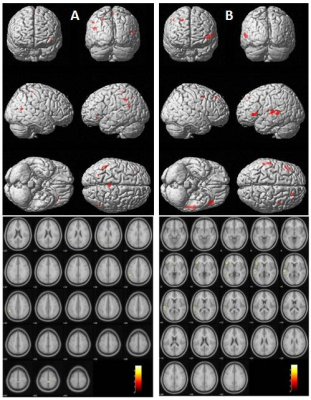3904
Neurobiology of Financial Decision-Making: An fMRI Based Study Using IGT1University School of Management Studies, Guru Gobind Singh Indraprastha University, New Delhi, India, 2Department of NMR & MRI Facility, All India Institute of Medical Sciences, New Delhi, India, 3Department of Neurology, All India Institute of Medical Sciences, New Delhi, India
Synopsis
The neural underpinnings of financial behaviour using modified Iowa Gambling Task (IGT) was assessed through fMRI technique. Data was processed using SPM 12. The results reveal differential brain activation in fronto-parietal lesion patients (n=3, mean age: 47 ±12 years) with respect to controls (n=6, mean age:42±17years). IGT results demonstrated activations during experience of majorly four conditions viz. gains, losses, draws and penalty. The decision-making and associated tasks invoked memory, attention and execution networks providing the insights about the underlying structures of financial investment behaviour.
INTRODUCTION
Financial decision-making process (study in Neurofinance) is emerging as an intriguing field of research, as it is subjected to the evaluation of risk, reward and penalty involved (1). Iowa Gambling Task (IGT) has been used for deducing financial behavior through actual behavior in real time decision-making (1–4). The use of game theory in neuroeconomics explains the rewarding and learning structures that work and interact with each other to determine strategic and optimal choices during investment (5). IGT estimates the utilisation of return distribution through description and learning of outcomes (probability for reward) and may be taken as a proxy for financial market investment. This can be further supported by the fact that in financial markets, probabilistic description about the risk-reward determination is available and investors invest on the basis of experience and learning. IGT has been widely used for understanding the decision-making (3,4,6). The task has been modified for use in analysing the concept of decision-making with varying objectives (3,4,7,8). The present study investigates the neurobiology of the decision-making process through fMRI technique using Iowa Gambling task.METHODS
The study is carried out in frontoparietal lesion patients (n=3, mean age: 47 ±12 years) and controls (n=6, mean age: 42±17years). IGT task is presented using Superlab 5.0 (Cedrus Corporation, San Pedro, CA, USA) to suit fMRI requirements with MR compatible joystick (Current Designs, USA) usage, modified from the IOWA Gambling task, designed by Bechara, Damasio, Damasio, & Anderson (1) and later by SuperLab community. The task consists of four deck of cards with hundred trials and each trial is subjected to reward and penalties. However, two deck of cards are advantageous in longer run and the other two prove to be advantageous in shorter run but disadvantageous in longer run. In our study, we have separated the 100 trials in 50-50 trials in block design form. The first 50 trials are representative of training and assessing the possible outcome of reward and penalty by the subjects. We have used block design method for IGT trials to assess the brain activity that may transpire for a longer duration during gambling (5). Secondly, the pre and post training effect in gambling can be determined where a baseline effect (to knock off the card effect) is created after 50 trials and also in the beginning of the experiment. The baseline is scheduled for 28 seconds wherein 14 seconds are devoted to depict the display of cards (at any of the four card locations) and the other 14 seconds presents for fixation (Plus (+) sign). Each trial event is separated by six seconds for stimulus representation, motor response, planning and execution of the decision. Scans are carried out using 32 channel head coil in Ingenia 3T (M/s Philips Medical Systems), and the response of the joystick coupled to Lumina Controller (Cedrus 3G, USA) were recorded. Whole brain 3D T1W1 using TFE sequence is used for overlaying BOLD activation. The data is processed using SPM (Statistical Parametric Mapping, version SPM12) using standard pipeline (9).RESULTS
The IGT results demonstrated activations during experience of four conditions viz. gains, losses, draws and penalty. During decision-making, trials with respect to only card effect (IGT trials minus card effect) revealed activations in middle temporal gyrus, paracentral lobule, precuneus, superior temporal gyrus, inferior frontal gyrus and supramarginal gyrus in patients with respect to controls (Table 1, Figure 1A). Decision-making with respect to card effect and fixation (IGT trials minus card effect and fixation) exhibited activations in superior temporal gyrus, middle temporal gyrus, inferior frontal gyrus, superior frontal gyrus, insula and middle frontal gyrus in patients in comparison with controls (Table 2, Figure 1B).DISCUSSION
IGT represents probabilistic determination of outcome rewards and penalties with learning and experience as other important factors. In this, pre-training phase of IGT 1, out of three patients; A and B performed poorly making a gain of $1950 and $3150 respectively. While patient C performed well in IGT 1 with a gain of $2200. Patients A and B made significant gains in IGT 2 with $3150 and $3100 respectively while patient C performed poorly in IGT 2 with $1500. The task-related activations may be attributed to experience, working memory and decision-making. The activation of superior temporal gyrus (STG) and precuneus may be associated with the shifting to other deck of cards and guide the decisions during winning and/or losing concurrent with literature (3,10). Right superior frontal gyrus activation may be associated with the working memory and cognitive functions. Insula activation may be associated with the planning and execution phase of the decision-making task (11).CONCLUSION
The decision-making and associated tasks invoked memory, attention and execution networks providing the insights about the underlying structures of financial investment behaviour.Acknowledgements
No acknowledgement found.References
1. Bechara A, Damasio AR, Damasio H, Anderson SW. Insensitivity to future consequences following damage to human prefrontal cortex. Cognition. 1994;50(1–3):7–15.
2. Gabay AS, Radua J, Kempton MJ, Mehta MA. The Ultimatum Game and the brain: A meta-analysis of neuroimaging studies. Neurosci Biobehav Rev [Internet]. 2014;47:549–58. Available from: http://dx.doi.org/10.1016/j.neubiorev.2014.10.014
3. Lin CH, Chiu YC, Cheng CM, Hsieh JC. Brain maps of Iowa gambling task. BMC Neurosci. 2008;9:1–15.
4. Volk S, Köhler T. Brains and Games. Organ Res Methods. 2012;15(4):522–52.
5. Kagel J, Roth A. Handbook of Experimental Economics. Vol. 2. Princeton university press; 2016. 1–69 p.
6. Homberg JR. Serotonin and decision making processes. Neurosci Biobehav Rev [Internet]. 2012;36(1):218–36. Available from: http://dx.doi.org/10.1016/j.neubiorev.2011.06.001
7. Xue G, Chen C, Lu Z-L, Dong Q. Brain Imaging Techniques and Their Applications in Decision-Making Research. Acta Psychol Sin. 2010;42(1):120–37.
8. Stanton SJ, Liening SH, Schultheiss OC. Testosterone is positively associated with risk taking in the Iowa Gambling Task. Horm Behav. 2011;59(2):252–6.
9. Friston KJ. Statistical parametric mapping. In Neuroscience databases 2003 (pp. 237-250), Springer, Boston, MA.
10. Paulus MP, Hozack N, Zauscher B, McDowell JE, Frank L, Brown GG, et al. Prefrontal, parietal, and temporal cortex networks underlie decision-making in the presence of uncertainty. Neuroimage. 2001;13(1):91–100.
11. Droutman V, Bechara A, Read SJ. Roles of the Different Sub-Regions of the Insular Cortex in Various Phases of the Decision-Making Process. Front Behav Neurosci. 2015;9(November):1–14.11.
Figures


